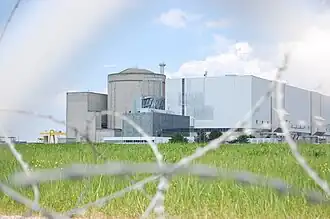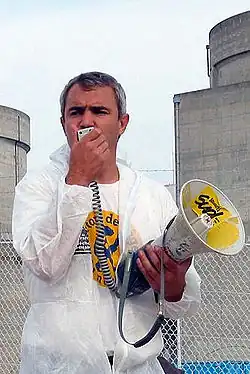Blayais Nuclear Power Plant
| Blayais Nuclear Power Plant | |
|---|---|
 | |
| Official name | Centrale nucléaire du Blayais |
| Country | France |
| Location | Blaye, Gironde, Nouvelle-Aquitaine |
| Coordinates | 45°15′21″N 0°41′35″W / 45.25583°N 0.69306°W |
| Status | Operational |
| Construction began | Units 1–2: 1 January 1977 Units 3–4: 1 April 1978 |
| Commission date | Unit 1: 1 December 1981 Unit 2: 1 February 1983 Unit 3: 14 November 1983 Unit 4: 1 October 1983 |
| Owner | EDF |
| Operator | EDF |
| Nuclear power station | |
| Reactor type | PWR |
| Reactor supplier | Framatome |
| Cooling source | Gironde estuary |
| Thermal capacity | 4 × 2785 MWth |
| Power generation | |
| Units operational | 4 × 910 MW |
| Make and model | CP1 |
| Nameplate capacity | 3640 MW |
| Capacity factor | 82.73% (2017) 75.15% (lifetime) |
| Annual net output | 26,380 GWh (2017) |
| External links | |
| Website | Centrale nucléaire du Blayais |
| Commons | Related media on Commons |


The Blayais Nuclear Power Plant is a nuclear plant on the banks of the Gironde estuary near Blaye, France operated by Électricité de France.
Description
The power plant has 4 pressurized water reactors – producing 951 MW gross and 910 MW net each.[1] They were commissioned from 1981 to 1983. The plant has 1200 EDF employees and 350 permanent workers.
The four reactors produce about 25 TWh per year[1] which is about 5% of the total electricity consumption in France (2015: 476 TWh).[2] Since its commissioning and up to 2024, the Blayais nuclear power plant has produced around 1000 TWh.[1]
Selected incidents
1999 flooding
On the evening of 27 December 1999, a combination of the incoming tide and high winds overwhelmed the sea walls at the plant and causing parts of the plant to be flooded.[3] The event resulted in the loss of the plant's off-site power supply and knocked out several safety-related backup systems, resulting in a 'level 2' event on the International Nuclear Event Scale.[4]
At the time, units 1, 2 and 4 were at full power, while unit 3 was shut down for refuelling.[3] The operation of units 1 and 2 were affected by flood damage to a number of water pumps and distribution panels, all four units lost their 225 kV power supplies, while units 2 and 4 also lost their 400 kV power supplies.[3] Diesel backup generators were employed to maintain power to plants 2 and 4 until the 400 kV supply was restored.[3] Over the following days an estimated 90,000 m3 (3,200,000 cu ft) of water was pumped out of the flooded buildings.[3]
On 5 January, the regional newspaper Sud-Ouest ran the following headline without being contradicted: "Very close to a major accident", explaining that a catastrophe had been narrowly avoided.[5]
The flooding resulted in fundamental changes to the evaluation of flood risk at nuclear power plants, and in the precautions taken.[6]
In Germany the flooding prompted the Federal Ministry for Environment, Nature Conservation and Nuclear Safety to order an evaluation of the German nuclear power plants.[3]
Opposition

The continued operation of the Blayais plant is opposed by the local anti-nuclear group 'TchernoBlaye' (a portmanteau of the French spelling of Chernobyl and Blaye, the nearest town), formed by Stéphane Lhomme on 15 December 1999.[7]
References
- ^ a b c "IAEA PRIS Power Reactor Information System - France". Retrieved 30 September 2017.
- ^ "2015 Annual Electricity Report" (PDF). RTE, the French transmission system operator. Retrieved 30 September 2017.
- ^ a b c d e f Generic Results and Conclusions of Re-evaluating the Flooding in French and German Nuclear Power Plants Archived 6 October 2011 at the Wayback Machine J. M. Mattéi, E. Vial, V. Rebour, H. Liemersdorf, M. Türschmann, Eurosafe Forum 2001, published 2001, accessed 21 March 2011
- ^ COMMUNIQUE N°7 - INCIDENT SUR LE SITE DU BLAYAIS Archived 27 May 2013 at the Wayback Machine ASN, published 1999-12-30, accessed 2011-03-22
- ^ Sud-Ouest, 5 janvier 2000 - Centrale de Blaye : Très près de l'accident majeur
- ^ Lessons Learned from 1999 Blayais Flood: Overview of the EDF Flood Risk Management Plan, Eric de Fraguier, EDF, published 2010-03-11, accessed 22 March 2011
- ^ L'histoire de TchernoBlaye TchernoBlaye, accessed 29 March 2011